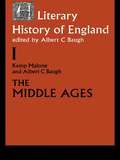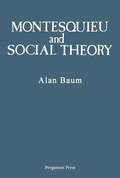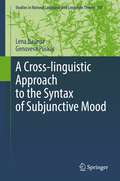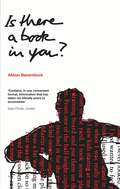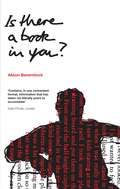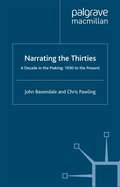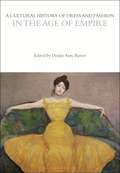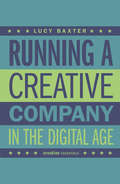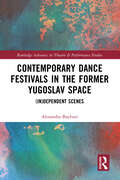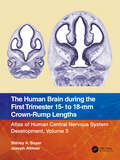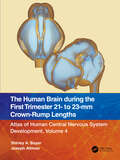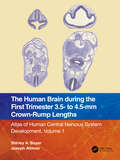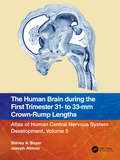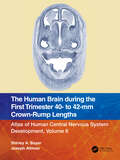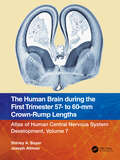- Table View
- List View
A Literary History of England: The Middle Ages (to #1500)
by Albert C. Baugh Kemp MaloneThe paperback edition, in four volumes, of this standard work will make it readily available to students. The scope of the work makes it valuable as a work of reference, connecting one period with another and placing each author clearly in the setting of his time. Reviewing the first edition, The Times Literary Supplement commented: ‘in inclusiveness and in judgment it has few rivals of its kind’. This first volume covers The Middle Ages (to 1500) in two sections: The Old English Period (to 1100) by Kemp Malone (John Hopkins University), and The Middle English Period (1100-1500) by Albert C. Baugh (University of Pennsylvania).
Montesquieu and Social Theory
by John Alan BaumMontesquieu and Social Theory details Montesquieu’s contribution to sociology. The title chronicles Montesquieu’s work that led to establishing the fundamentals and principles of sociology. The text first details Montesquieu’s biographical account, and then proceeds to discussing the Montesquieu’s motivation in his works. The next chapters encompass Montesquieu’s works, which include Persian Letter; Considerations on the Causes of the Greatness of the Romans and their Decline; and (On) The Spirit of the Laws. The last chapter details Montesquieu's influence in the late 18th and early 19th centuries. The book will be of great interest to anyone who has a keen interest in the development of social science.
Jewish American Chronology: Chronologies of the American Mosaic
by Mark K. BaumanThis comprehensive and analytical history of American Jews and Judaism from the Colonial Era to the present explores the impact of America on Jews and of Jews on America.Covering more than four centuries from the Colonial Era forward, Jewish American Chronology offers an introduction to the history of American Jews and Judaism, using individual examples, personality profiles, and illustrations to bring fundamental patterns and major themes to life. Arranged chronologically, the entries illustrate how a variety of different Jewish groups and individuals have adapted to America, both changing in accordance with time and place and retaining tradition and culture, even as they became thoroughly American.Readers will learn how Jews have created community and institutions, confronted anti-Semitism, and interacted among themselves and with other groups. They will read about immigration, migration, and socioeconomic mobility. And they will discover how Jews have filled critical economic niches, contributed disproportionately in a variety of endeavors, and changed over time and in reaction to circumstances. In this wide-ranging work, Jewish Americans are depicted in a balanced and accurate manner, describing Nobel Prize winners and standout economic success stories as well as those who achieved fame and notoriety in other ways.
A Cross-linguistic Approach to the Syntax of Subjunctive Mood (Studies in Natural Language and Linguistic Theory #101)
by Lena Baunaz Genoveva PuskásThis monograph gives a unified account of the syntactic distribution of subjunctive mood across languages, including Romance, Balkan (South Slavic and Modern Greek), and Hungarian, among others. Starting from a close scrutiny of the environments in which subjunctive mood occurs and of its semantic contribution, we present a feature-based approach which reveals the common properties of the class of verbs which embed subjunctive, and which takes into account the variation in subjunctive-related complementizers. Two main proposals can be highlighted: (i) the lexical semantics of the main clause predicate plays a crucial role in mood selection. More specifically subjunctive mood is regulated by a specific property of the main predicate, the emotive property, which is associated with the external argument of the embedding verb (usually the Subject). The book proposes a nanosyntactic analysis of the internal structure of embedding verbs. (ii) Cross- and intra-linguistic variations are dealt with according to different patterns of lexicalization, i.e., variations depend on what portions of the verb’s and complementizer’s functional sequence is lexicalized and on how it is packaged by languages. In doing so, this approach provides a uniform account of the phenomenon of embedded subjunctives. The monograph takes a novel, feature-based approach to the question of subjunctive licensing, providing a detailed analysis of the features of the matrix verb, of the complementizer and of the embedded subjunctive clause. It is also based on a wide empirical coverage, ranging from the relatively well-studied groups of Romance and Balkan languages to less explored languages from non-Indo-European families (Hungarian).
Is there a book in you?
by Alison BaverstockMany people feel they might have a book in them - but how do you know whether you have what it takes to be a writer, whether your writing is any good, what you should write about and whether you should dedicate proper time to begin your dream? This book asks pertinent questions of you via a questionnaire to help you discover whether there is a talented writer in you. Each chapter provides background to the relevant point in the questionnaire. Packed with advice from experienced writers including known authors; P D James, Philip Pullman, Jacqueline Wilson, Margaret Drabble, Katie Fforde and more. Expert advice from Daniel Roche (BA President), independent booksellers, publishers Helen Fraser (Penguin) and Ian Trewin (Chairman Cheltenham Literary Festival and administrator, Man Booker Prize), agents and creative writing tutors. Foreword by columnist and writer Katharine Whitehorn.
Is there a book in you?
by Alison BaverstockMany people feel they might have a book in them - but how do you know whether you have what it takes to be a writer, whether your writing is any good, what you should write about and whether you should dedicate proper time to begin your dream? This book asks pertinent questions of you via a questionnaire to help you discover whether there is a talented writer in you. Each chapter provides background to the relevant point in the questionnaire. Packed with advice from experienced writers including known authors; P D James, Philip Pullman, Jacqueline Wilson, Margaret Drabble, Katie Fforde and more. Expert advice from Daniel Roche (BA President), independent booksellers, publishers Helen Fraser (Penguin) and Ian Trewin (Chairman Cheltenham Literary Festival and administrator, Man Booker Prize), agents and creative writing tutors. Foreword by columnist and writer Katharine Whitehorn.
Narrating the Thirties: A Decade in the Making, 1930 to the Present
by J. Baxendale C. PawlingIn a series of case-studies, ranging widely from documentary film and the writings of J.B. Priestley to postwar historiography and Remains of the Day, this book explores the ever-changing and hotly contested narratives of Britain in the 1930s. The authors argue that images of 'the Thirties' have been a continual presence in the construction of the wartime and postwar world, and in particular in the emergent discourse of social democracy and its subsequent decline.
A Cultural History of Dress and Fashion in the Age of Empire (The Cultural Histories Series)
by Denise Amy BaxterDuring the nineteenth and early twentieth centuries the production of dress shifted dramatically from being predominantly hand-crafted in small quantities to machine-manufactured in bulk. The increasing democratization of appearances made new fashions more widely available, but at the same time made the need to differentiate social rank seem more pressing. In this age of empire, the coding of class, gender and race was frequently negotiated through dress in complex ways, from fashionable dress which restricted or exaggerated the female body to liberating reform dress, from self-defining black dandies to the oppressions and resistances of slave dress. Richly illustrated with over 100 images and drawing on a plethora of visual, textual and object sources, A Cultural History of Dress and Fashion in the Age of Empire presents essays on textiles, production and distribution, the body, belief, gender and sexuality, status, ethnicity, and visual and literary representations to illustrate the diversity and cultural significance of dress and fashion in the period.
Gotcha Again for Guys!: More Nonfiction Books to Get Boys Excited about Reading
by Kathleen A. Baxter Marcia Agness KochelHere's help in selecting current, nonfiction books that will get boys excited about reading.Enticing boys to read is still a hot topic. With chapters like "Disasters and Mysteries," "Gross and Disgusting," "Machines and the Military," and "Prehistoric Creatures," Gotcha Again for Guys!: More Nonfiction Books to Get Boys Excited about Reading is a treasure trove of recent nonfiction books that will interest boys in grades 3-8.This sixth entry in Baxter and Kochel's Gotcha series covers books published between 2007 and 2009, with a few oldies-but-goodies also included. The book is organized into 12 thematic chapters, each of which offers booktalks for a select number of titles, followed by a list of other high-interest, well-reviewed titles that correspond with the chapter's topic. Features new to this volume include numerous booklists to be copied and saved, as well as profiles of new and innovative nonfiction authors writing for this age group. In addition, the book features interviews with seven male authors of nonfiction books for boys.
Making Birdhouses: Easy and Advanced Projects
by Leon H. Baxter Gladstone CaliffThis practical guide for building birdhouses contains plans for more than fifty attractive and useful structures — from a one-room house for bluebirds to a forty-two-room structure for purple martins. In addition to instructions and diagrams for constructing houses for such avian varieties as robins, wrens and chickadees, the easy-to-follow text also provides suggestions for feeding devices, bird house materials, methods of finishing exteriors, and winter care for birds. An authoritative, how-to book that will appeal to beginning and veteran woodcrafters alike, Making Birdhouses also features a supplement with easy projects for novices — among them simple structures for woodpeckers, a box for robins, and an “A-frame” for nuthatches. Plans for houses made from such common objects as gourds, a flower pot, tin cans, and an old lantern are also included.Detailed instructions and diagrams assure successful completion of projects that will satisfy builders as well as their feathered friends.
Running a Creative Company in the Digital Age: How to successfully set up your own media company
by Lucy BaxterRunning a Creative Company in the Digital Age helps you navigate the landscape and learn from seasoned professionals, understanding the mistakes they made so you don't have to make them too!In the modern media industry digital content production is cheaper, more democratic and accessible and it's becoming more attractive - and easier - to do things your own way. So what if you want to set up on your own? This book will guide you through the joys and pitfalls of running your own creative company in today's diverse media climate. This is a nuts and bolts guide to company set up, structure, management and content production for digital platforms, TV, festivals, charities, education, brands and businesses. Full of tips for creating innovative business models and platforms, handling tricky people and situations, funding and networking, these pages are your touchstone for making that bold first move into founder/managing director status. Featuring interviews with industry experts including digital agency and production company CEOs, creative entrepreneurs, crowd funding platforms, investors, film makers, media lawyers and accountants.'Running a Creative Company in the Digital Age will definitely help you understand how to go about this. It’s essential reading for any writers and filmmakers who want to work for themselves or set up their own company' - Writesofluid'Should be on the reading list of every Media/Arts/Entrepreneurship college course in the country' - Rajesh Thind, founder of Pindu Productions'This plain-speaking, accessible guide to setting up a creative business demystifies the entire process, and does so from the unique perspective of a creative who has been there, done it and has the scars to prove it' - Nicola Lees, WFTV
Contemporary Dance Festivals in the Former Yugoslav Space: (in)dependent Scenes (Routledge Advances in Theatre & Performance Studies)
by Alexandra BaybuttThis book expands the understanding of conditions defining the creation and circulation of contemporary dance that differ across Europe. It focuses on festival-making connected with the Balkan regional project ‘Nomad Dance Academy’ (NDA), and highlights collective approaches to sustain a theorisation of festivals using the concepts of dissensus and imperceptible politics. Drawing from anthropological methods, three festivals PLESkavica, Slovenia; Kondenz, Serbia and LocoMotion, North Macedonia, are explored through social, political and historical currents affecting curatorial practice. This book closely follows how festival-makers navigate the values of international development that during and after the Yugoslav wars looked to art as part of peacekeeping and nation-building processes. This coincided with increasing discourse and practices of contemporary dance that gained momentum in the 1980s alongside European festivalisation. I show how contemporary dance acts as an agent for transformation, but also a carrier of older forms of social organisation, reflecting methods and values of Yugoslav Worker Self-management that are deployed by the groups creating the festivals. This book will be of interest to dance scholars as well as researchers tracing the long-term effects of the dissolution of the Socialist Federal Republic of Yugoslavia.
Contemporary Dance Festivals in the Former Yugoslav Space: (in)dependent Scenes (Routledge Advances in Theatre & Performance Studies)
by Alexandra BaybuttThis book expands the understanding of conditions defining the creation and circulation of contemporary dance that differ across Europe. It focuses on festival-making connected with the Balkan regional project ‘Nomad Dance Academy’ (NDA), and highlights collective approaches to sustain a theorisation of festivals using the concepts of dissensus and imperceptible politics. Drawing from anthropological methods, three festivals PLESkavica, Slovenia; Kondenz, Serbia and LocoMotion, North Macedonia, are explored through social, political and historical currents affecting curatorial practice. This book closely follows how festival-makers navigate the values of international development that during and after the Yugoslav wars looked to art as part of peacekeeping and nation-building processes. This coincided with increasing discourse and practices of contemporary dance that gained momentum in the 1980s alongside European festivalisation. I show how contemporary dance acts as an agent for transformation, but also a carrier of older forms of social organisation, reflecting methods and values of Yugoslav Worker Self-management that are deployed by the groups creating the festivals. This book will be of interest to dance scholars as well as researchers tracing the long-term effects of the dissolution of the Socialist Federal Republic of Yugoslavia.
The Human Brain during the First Trimester 15- to 18-mm Crown-Rump Lengths: Atlas of Human Central Nervous System Development, Volume 3
by Shirley A. Bayer Joseph AltmanThis third of 15 short atlases reimagines the classic 5-volume Atlas of Human Central Nervous System Development. This volume presents serial sections from specimens between 15 mm and 18 mm with detailed annotations, together with 3D reconstructions. An introduction summarizes human CNS development by using high-resolution photos of methacrylate-embedded rat embryos at a similar stage of development as the human specimens in this volume. The accompanying Glossary gives definitions for all the terms used in this volume and all the others in the Atlas. Features Classic anatomical atlas Detailed labeling of structures in the developing brain offers updated terminology and the identification of unique developmental features, such as germinal matrices of specific neuronal populations and migratory streams of young neurons Appeals to neuroanatomists, developmental biologists, and clinical practitioners A valuable reference work on brain development that will be relevant for decades
The Human Brain during the First Trimester 15- to 18-mm Crown-Rump Lengths: Atlas of Human Central Nervous System Development, Volume 3
by Shirley A. Bayer Joseph AltmanThis third of 15 short atlases reimagines the classic 5-volume Atlas of Human Central Nervous System Development. This volume presents serial sections from specimens between 15 mm and 18 mm with detailed annotations, together with 3D reconstructions. An introduction summarizes human CNS development by using high-resolution photos of methacrylate-embedded rat embryos at a similar stage of development as the human specimens in this volume. The accompanying Glossary gives definitions for all the terms used in this volume and all the others in the Atlas. Features Classic anatomical atlas Detailed labeling of structures in the developing brain offers updated terminology and the identification of unique developmental features, such as germinal matrices of specific neuronal populations and migratory streams of young neurons Appeals to neuroanatomists, developmental biologists, and clinical practitioners A valuable reference work on brain development that will be relevant for decades
The Human Brain during the First Trimester 21- to 23-mm Crown-Rump Lengths: Atlas of Human Central Nervous System Development, Volume 4
by Shirley A. Bayer Joseph AltmanThis fourth of 15 short atlases reimagines the classic 5-volume Atlas of Human Central Nervous System Development. This volume presents serial sections from specimens between 21 mm and 23 mm with detailed annotations, together with 3D reconstructions. An introduction summarizes human CNS development by using high-resolution photos of methacrylate-embedded rat embryos at a similar stage of development as the human specimens in this volume. The accompanying Glossary gives definitions for all the terms used in this volume and all the others in the Atlas. Key Features Classic anatomical atlases Detailed labeling of structures in the developing brain offers updated terminology and the identification of unique developmental features, such as, germinal matrices of specific neuronal populations and migratory streams of young neurons Appeals to neuroanatomists, developmental biologists, and clinical practitioners. A valuable reference work on brain development that will be relevant for decades
The Human Brain during the First Trimester 21- to 23-mm Crown-Rump Lengths: Atlas of Human Central Nervous System Development, Volume 4
by Shirley A. Bayer Joseph AltmanThis fourth of 15 short atlases reimagines the classic 5-volume Atlas of Human Central Nervous System Development. This volume presents serial sections from specimens between 21 mm and 23 mm with detailed annotations, together with 3D reconstructions. An introduction summarizes human CNS development by using high-resolution photos of methacrylate-embedded rat embryos at a similar stage of development as the human specimens in this volume. The accompanying Glossary gives definitions for all the terms used in this volume and all the others in the Atlas. Key Features Classic anatomical atlases Detailed labeling of structures in the developing brain offers updated terminology and the identification of unique developmental features, such as, germinal matrices of specific neuronal populations and migratory streams of young neurons Appeals to neuroanatomists, developmental biologists, and clinical practitioners. A valuable reference work on brain development that will be relevant for decades
The Human Brain during the First Trimester 3.5- to 4.5-mm Crown-Rump Lengths: Atlas of Human Central Nervous System Development, Volume 1
by Shirley A. Bayer Joseph AltmanThis first of 15 short atlases reimagines the classic 5-volume Atlas of Human Central Nervous System Development. This volume presents serial sections from specimens between 3.5 mm and 4.5 mm with detailed annotations, together with 3D reconstructions. An introduction summarizes human CNS development by using high-resolution photos of methacrylate-embedded rat embryos at a similar stage of development as the human specimens in this volume. The accompanying Glossary gives definitions for all the terms used in this volume and all the others in the Atlas. Features Classic anatomical atlas Detailed labeling of structures in the developing brain offers updated terminology and the identification of unique developmental features, such as germinal matrices of specific neuronal populations and migratory streams of young neurons Appeals to neuroanatomists, developmental biologists, and clinical practitioners A valuable reference work on brain development that will be relevant for decades
The Human Brain during the First Trimester 3.5- to 4.5-mm Crown-Rump Lengths: Atlas of Human Central Nervous System Development, Volume 1
by Shirley A. Bayer Joseph AltmanThis first of 15 short atlases reimagines the classic 5-volume Atlas of Human Central Nervous System Development. This volume presents serial sections from specimens between 3.5 mm and 4.5 mm with detailed annotations, together with 3D reconstructions. An introduction summarizes human CNS development by using high-resolution photos of methacrylate-embedded rat embryos at a similar stage of development as the human specimens in this volume. The accompanying Glossary gives definitions for all the terms used in this volume and all the others in the Atlas. Features Classic anatomical atlas Detailed labeling of structures in the developing brain offers updated terminology and the identification of unique developmental features, such as germinal matrices of specific neuronal populations and migratory streams of young neurons Appeals to neuroanatomists, developmental biologists, and clinical practitioners A valuable reference work on brain development that will be relevant for decades
The Human Brain during the First Trimester 31- to 33-mm Crown-Rump Lengths: Atlas of Human Central Nervous System Development, Volume 5
by Shirley A. Bayer Joseph AltmanThis fifth of 15 short atlases reimagines the classic 5-volume Atlas of Human Central Nervous System Development. This volume presents serial sections from specimens between 31 mm and 33 mm with detailed annotations, together with 3D reconstructions. An introduction summarizes human CNS development by using high-resolution photos of methacrylate-embedded rat embryos at a similar stage of development as the human specimens in this volume. The accompanying Glossary gives definitions for all the terms used in this volume and all the others in the Atlas. Features Classic anatomical atlases Detailed labeling of structures in the developing brain offers updated terminology and the identification of unique developmental features, such as, germinal matrices of specific neuronal populations and migratory streams of young neurons Appeals to neuroanatomists, developmental biologists, and clinical practioners A valuable reference work on brain development that will be relevant for decades
The Human Brain during the First Trimester 31- to 33-mm Crown-Rump Lengths: Atlas of Human Central Nervous System Development, Volume 5
by Shirley A. Bayer Joseph AltmanThis fifth of 15 short atlases reimagines the classic 5-volume Atlas of Human Central Nervous System Development. This volume presents serial sections from specimens between 31 mm and 33 mm with detailed annotations, together with 3D reconstructions. An introduction summarizes human CNS development by using high-resolution photos of methacrylate-embedded rat embryos at a similar stage of development as the human specimens in this volume. The accompanying Glossary gives definitions for all the terms used in this volume and all the others in the Atlas. Features Classic anatomical atlases Detailed labeling of structures in the developing brain offers updated terminology and the identification of unique developmental features, such as, germinal matrices of specific neuronal populations and migratory streams of young neurons Appeals to neuroanatomists, developmental biologists, and clinical practioners A valuable reference work on brain development that will be relevant for decades
The Human Brain during the First Trimester 40- to 42-mm Crown-Rump Lengths: Atlas of Human Central Nervous System Development, Volume 6
by Shirley A. Bayer Joseph AltmanThis sixth of 15 short atlases reimagines the classic 5-volume Atlas of Human Central Nervous System Development. This volume presents serial sections from specimens between 40 mm and 42 mm with detailed annotations, together with 3D reconstructions. An introduction summarizes human CNS development by using high-resolution photos of methacrylate-embedded rat embryos at a similar stage of development as the human specimens in this volume. The accompanying Glossary gives definitions for all the terms used in this volume and all the others in the Atlas. Features Classic anatomical atlas Detailed labeling of structures in the developing brain offers updated terminology and the identification of unique developmental features, such as, germinal matrices of specific neuronal populations and migratory streams of young neurons Appeals to neuroanatomists, developmental biologists, and clinical practitioners A valuable reference work on brain development that will be relevant for decades
The Human Brain during the First Trimester 40- to 42-mm Crown-Rump Lengths: Atlas of Human Central Nervous System Development, Volume 6
by Shirley A. Bayer Joseph AltmanThis sixth of 15 short atlases reimagines the classic 5-volume Atlas of Human Central Nervous System Development. This volume presents serial sections from specimens between 40 mm and 42 mm with detailed annotations, together with 3D reconstructions. An introduction summarizes human CNS development by using high-resolution photos of methacrylate-embedded rat embryos at a similar stage of development as the human specimens in this volume. The accompanying Glossary gives definitions for all the terms used in this volume and all the others in the Atlas. Features Classic anatomical atlas Detailed labeling of structures in the developing brain offers updated terminology and the identification of unique developmental features, such as, germinal matrices of specific neuronal populations and migratory streams of young neurons Appeals to neuroanatomists, developmental biologists, and clinical practitioners A valuable reference work on brain development that will be relevant for decades
The Human Brain during the First Trimester 57- to 60-mm Crown-Rump Lengths: Atlas of Human Central Nervous System Development, Volume 7
by Shirley A. Bayer Joseph AltmanThe seventh of 15 short atlases reimagining the classic 5-volume Atlas of Human Central Nervous System Development. This volume presents serial sections from specimens between 57 mm and 60 mm with detailed annotations, together with 3D reconstructions. An introduction summarizes human CNS development by using high-resolution photos of methacrylate-embedded rat embryos at a similar stage of development as the human specimens in this volume. The accompanying Glossary gives definitions for all the terms used in this volume and all the others in the Atlas. Features • Classic anatomical atlas • Detailed labeling of structures in the developing brain offers updated terminology and the identification of unique developmental features, such as, germinal matrices of specific neuronal populations and migratory streams of young neurons • Appeals to neuroanatomists, developmental biologists, and clinical practitioners • A valuable reference work on brain development that will be relevant for decades
The Human Brain during the First Trimester 57- to 60-mm Crown-Rump Lengths: Atlas of Human Central Nervous System Development, Volume 7
by Shirley A. Bayer Joseph AltmanThe seventh of 15 short atlases reimagining the classic 5-volume Atlas of Human Central Nervous System Development. This volume presents serial sections from specimens between 57 mm and 60 mm with detailed annotations, together with 3D reconstructions. An introduction summarizes human CNS development by using high-resolution photos of methacrylate-embedded rat embryos at a similar stage of development as the human specimens in this volume. The accompanying Glossary gives definitions for all the terms used in this volume and all the others in the Atlas. Features • Classic anatomical atlas • Detailed labeling of structures in the developing brain offers updated terminology and the identification of unique developmental features, such as, germinal matrices of specific neuronal populations and migratory streams of young neurons • Appeals to neuroanatomists, developmental biologists, and clinical practitioners • A valuable reference work on brain development that will be relevant for decades
